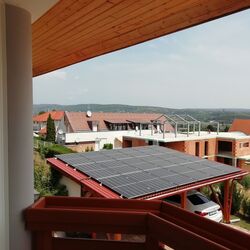Unique delicacies preserved in a jar
At Margit Kreiner’s stand at the Hévíz Farmers’ Market, you can sample smoked, spiced quail eggs, wild garlic pesto, paprika creams, syrups, and jams. In Raposka, a quiet corner of the Balaton Uplands at the foot of Szent György Hill, nearly 400 quails chirp daily under the care of Margit and her daughter, thanking them with hundreds of tiny, nutritious eggs. Quail eggs are considered a healthy delicacy, but when smoked and preserved in olive oil, they become a true gourmet treat.
Farming as a passion
Margit has been immersed in agriculture and homestead farming her whole life. Over the years, she has gained extensive experience in animal husbandry.
Previously, her family lived in Káptalantóti, where they raised hundreds of poultry and sheep, produced herbal teas, and cultivated lavender and roses. After moving to Raposka, she continued her passion on a smaller scale. Inspired by an experienced friend, she began raising quails, learning everything through reading, hands-on experience, and trial and error.
Today, she and her daughter care for several hundred quails, providing them with fresh water and high-quality feed daily. From the start, Margit has avoided industrial feeds, sourcing natural grains — corn, wheat, barley, peas, soy — from a nearby farm. This ensures the quails remain healthy and their eggs retain a rich, characteristic flavor.
As Margit says “Anyone who has tasted eggs from industrially-fed poultry and then tries one from a home-raised bird fed with natural grains will immediately notice the difference.” Not only is the taste superior, but the appearance is too. The yolk has a deeper, more vibrant color that remains golden even after cooking.
Artisan processing, creative flavors
After boiling, the quail eggs are soaked in brine for several hours, then smoked over beechwood. The firm, white eggs are then preserved in olive oil with garlic, chili, wild garlic, or other seasonal herbs.
Each flavor is the result of Margit’s own experiments — nothing reaches the market until she deems it 100% perfect. The most popular flavors include plain, garlic, and chili. Tip: Don’t discard the marinade — the aromatic olive oil can be used for cooking after the eggs are gone!
Customers often suggest new flavor ideas, which Margit gladly tries to bring to life. While the smoked quail eggs are the flagship product, Margit also makes wild garlic pesto, sweet and spicy paprika creams from homegrown vegetables, and fruit-based jams and syrups.
Product highlights
Wild garlic pesto
Made from freshly harvested wild garlic at its seasonal peak, this pesto combines finely chopped leaves with olive oil, salt, and either walnuts or chili. Margit uses only the leafy parts to preserve the fresh, mildly garlicky aroma.
She collects the wild garlic herself from trusted local spots, sometimes with the help of family. The versions with walnuts or chili add a distinctive twist to this spring delicacy. Perfect for pasta, spread on toast, as a meat accompaniment, or as a salad dressing. No preservatives are used.
Spiced smoked quail eggs in olive oil
One of Margit’s most unique creations, these smoked quail eggs preserved in olive oil are a true delicacy. The quails are home-raised on natural feed, resulting in eggs rich in vitamins and minerals. Preparing these tiny treasures is a meticulous process: The eggs are soaked in vinegar water to remove natural pigments, then boiled in salted water, cooled, and peeled by hand. After that, they are smoked over beechwood for three hours.
The prepared eggs are then submerged in olive oil, plain or flavored with garlic, chili, or seasonal herbs. The oil acts not only as a preservative but also captures the smoky and spicy aromas, making it perfect for later culinary use. Made exclusively with natural ingredients, free from additives and preservatives, this product has a shelf life of six months.
Enjoy as an appetizer, finger food, or salad topping — a true homemade delicacy from Raposka.
Where to buy
- Hévíz Farmers’ Market
- Liliomkert Market, Káptalantóti
The Life-Giving Winds of the Ice Age: How Loess Shaped the Land Did you know that Transdanubia’s rich, golden soils are actually a gift from the winds of the Ice Age? Loess isn’t just a dry geological term — it’s an ancient natural recipe that gave rise to some of the most fertile soils in the Carpathian Basin. Where vineyards grow today and birds nest in loess cliffs, strong winds once carried yellow dust across the landscape — for thousands of years. Learn how this unique sediment shaped the land and why loess is still essential for sustainable farming today. What Is Loess and How Did It Form? The term loess comes from the German word lose, meaning "loose." Loess is a fine-grained, yellowish sediment that was deposited during the Pleistocene epoch (2.58–0.01 million years ago), particularly during glacial periods. It formed in periglacial environments south of the great Scandinavian ice sheet — cold, dry landscapes with little or no vegetation. The dust was carried by strong Ice Age winds from floodplains and barren steppes, and slowly accumulated over tens of thousands of years. Eventually, calcium carbonate cemented these layers into loess, which developed characteristic vertical fissures. It’s important to note that the Pleistocene wasn't a single “Ice Age,” but a period that included alternating cold and warm phases — some even warmer than today. Loess and the Landscape Loess gave the Carpathian Basin — especially Transdanubia — its distinct terrain. Steep loess cliffs (sometimes up to 10 meters high), caves that provide nesting sites for bee-eaters and sand martins, centuries-old sunken roads carved into hillsides, and exposed root systems are all part of the landscape’s geological legacy. Together, they define the unique character of this region — shaped by time, wind, and stone. Fertility and Water Retention Loess-rich areas have produced some of the most fertile soils in the region. Many local producers farm on land that sits atop loess. This creates an excellent foundation for agriculture — not just because of the high humus content, but also because loess has outstanding water-holding capacity. Its vertical pores allow moisture to penetrate deeply and remain in the soil, even during dry periods. A Modern Echo — Dust from the Sahara Interestingly, the fine Saharan dust that now reaches Central Europe more frequently can be seen as a modern counterpart to loess-forming material. It’s a reminder that the powerful natural forces that shaped the land long ago are still at work today — just on a different scale.















